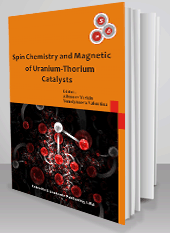Scientific & Academic Publishing
SAP is an open access publisher of journals covering a wide range of academic disciplines.
SAP is an open access publisher of journals covering a wide range of academic disciplines.

Description
Currently, much attention is devoted to the influence of magnetic and relativistic effects in catalysis. Study of the magnetic and relativistic effects also helps in understanding the fundamental issues such as the structure of chemical compounds and the nature of the chemical bond, the discovery of new chemical reactions.
Increased interest is the expansion of the practical use of uranium compounds in industrial catalysis of chemical reactions, structural materials and other fields of science and technology.
Features of the electronic structure of d-and f-elements are reflected in the increased catalytic properties of actinides.
Prospects of using uranium catalysts is unquestionable, as demonstrated by many studies.
Catalytic processes using uranium catalysts characterized stereospecific polymerization of conjugated diene.
Increased catalytic properties of these catalysts due to the influence f-orbitals on the formation of intermediate complexes and low levels of electronic transitions in the catalysts.
Presented results based on its own materials research work in the chemical laboratory.
The authors would like to thank Professors Lynn S. Francesconni (Hunter College, NY); Chistopher L. Cahill (George Washington University, DC), R. Savizky (Cooper Union, NY), Ronald Breslow, Mark Castildi (Columbia University, NY), Peter C. Burns (University of Notre Dame, Indiana), Maria Mentel (Brooklyn College, NY), Boris Zakharov (La Guardia, NY) for a discussion of the results.
The authors express their deep appreciation and gratitude Zhubanov K.A., Baiguzhin A.A., Orumbaev N.B., for their help in the discussion and chemical analysis, and providing some of the materials used in the individual chapters.
Table of Contents
Introduction
1. Preparation of Uranyl Complexes with Sugars
2. Catalytic Oxidation of U4 + to U6 + Oxygen in the Presence of a Catalyst "Muhamedzhan-1"
3. Field Tests of the Catalyst "Mukhamedzhan-1" for the Detoxification of Propellant UDMH in the Position the Space Center “Baikonur” in Kazakhstan
4. Chemical Interaction UO2Cl2 with α-and β-amino Acids in Aqueous and Organic Solution
5. Getting and X-ray Diffraction Analysis of the Uranium Catalyst SAPO-U, Nd, Sb, Bi on the Basis of Natural Zeolite Deposits Chankanayskoe
6. Development and Implementation of a Antiradiation Respirator "ARR-1" for Use in Uranium Mining
7. Purification of Industrial Solutions from Natural Radionuclide’s
8. A New Approach to Explaining the Oscillatory Oxidation of Arsenites, Stibnites and Vismutinites Using Magnetic Method
9. Synthesis Magnetic Uranium Catalysts Containing Co, Sn, Cr, Mn, Cd
10. Method of Catalytic Oxidation of U4+ to U6+ Using a Catalyst Muhamedzhan-1
11. Getting and X-Ray Diffraction Analysis of the Microsphere Catalyst U, Nd on the Basis Fly Ash of Thermal Power Plants
12. Effect of Magnetic Field on the Catalysis of Ligands in Non-Aqueous Solutions 122 Preparation of Uranyl Complexes with Sugars
13. A New Method of Producing Radionuclide-Labeled Microspheres for Radionuclide Therapy
14. Chemical Interaction UO2Cl2 with α- and β-Amino Acids in Aqueous and Organic Solution
15. Actual Directions of Complex Processing of Raw Uranium as the Development of the Production of Rare Earth Metals in Kazakhstan
16. X-ray Diffraction Analysis of the Microsphere Magnetic Catalyst of the Thorium-Uranium Catalyst for Fischer-Tropsch Synthesisc
17. New Regularity of the Magnetic Field and Relativistic Effects on Chemical Reactions in Catalysis for Example Nanostructured Magnetic Uranium Catalysts
18. A New approach to Modification of Rearrangements in Metallorganic Chemistry of Phosphorus, Arsenic, Antimony and Bismuth
19. Cleaning the Ion Exchange Resin Sorption of Uranium from Silicic Acid Solution "Ayanat"
20. Getting and X-Ray Diffraction Analysis of the Microsphere Magnetic Catalyst of the Thorium-Uranium Catalyst for Fischer-Tropsch Synthesis
21. The New Formulation of the Principle of the Periodic Table of the Elements
Conclusions
REFERENCES